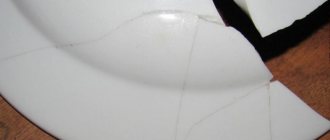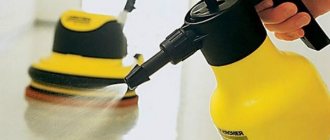Even natural stone in some cases can get damaged and scratched, which disrupts the decorative appearance of the cladding. If you decide to restore the shiny surface yourself, find out in 10 minutes of reading how to polish and grind marble and granite yourself. All the secrets of our masters are collected in this article.
What you will need for work:
- A power tool is a grinder, without which grinding marble and granite with your own hands is simply impossible (it’s better if it’s a reliable Makita brand).
- A special “adapter” is a holder for grinding and polishing discs, the so-called “caliper”. It looks like a rubber disc with a special fastening. For processing curved surfaces, a convex rubber caliper is purchased; for smooth surfaces, a flat one with sufficient rigidity is purchased.
- Diamond grinding discs and polishing wheels (“turtles”) of different numbers.
Next, we’ll look step by step at how to properly grind marble and granite, as well as how to polish them flawlessly.
Grinding granite and marble without errors
Expensive stone wall cladding or a window sill or tabletop will lose their appearance if scratches, especially deep ones, are visible on the surface. You can eliminate the unpleasant defect yourself, but this will require all operations to be carried out carefully and correctly.
How to grind granite at home and subsequent polishing:
- Take a grinder, attach the caliper and the diamond grinding disc to it. Here's how to grind granite and marble: to remove deep scratches, be sure to start grinding with large numbers of abrasive wheels (first No. 30, then 50, 100, 200 and then up to 400 for marble and 800 for granite, until you get a smooth surface without scratches). Do not forget to set the desired rotation speed for each circle (indicated in the instructions).
- Once sanded, start polishing: take the buffing wheels and continue working the surface of the stone, adding a small amount of polishing powder. It is advisable to start with wheel number 1500 and end with wheel number 3000 to achieve a flawless factory finish.
Remember: to avoid getting a “hole” when locally grinding granite and marble, be sure to process the border of the previous number with a transition to a total area that is a couple of centimeters wider.
If you have an angle grinder without a water supply, don’t worry: you can reduce dust formation and make polishing easier by using a regular spray bottle.
General information
Properties of granite
Before we introduce you to polishing granite, let's look at what kind of stone it is and find out its properties. The name "granite" comes from the word "granum", which means "grain". Granite is formed as a result of processes associated with a volcanic eruption. Hot magma, covering the earth's surface around the volcano, solidifies and absorbs fragments of stones of various rocks. The sintering of magma and various types of fragments of rocky soil leads to the formation of granite.
What are the physical properties of granite? Granite is very durable. It can withstand a load of more than 600 kg per 1 sq. cm.
Granite is a hard type of stone (Mohs 7). The stone easily tolerates temperature changes of 100 degrees because it contains quartz. But at the same time, quartz reduces the heat resistance of granite. At a temperature of about 700 degrees, the stone begins to melt and granite structures collapse.
High density and heavy weight do not allow the use of granite in the construction of mass housing. But recently it has gained popularity in the construction of individual buildings. Fine-grained granite with a diameter of more than 2 mm is most resistant to various damages.
Necessary tools for grinding granite
To grind and polish granite, you need tools that make it easier to process the stone manually:
- One of the important tools that you cannot do without when polishing granite is a grinder. This power tool is capable of polishing the surface of natural stone and grinding it. It is best to take a tool from the famous Makita brand.
- A support holder for grinding and polishing discs will help restore a polished item to its former beauty. It is a rubber disk with a special fastening. The caliper can be flat or convex. If you need to polish a curved surface of natural stone, then it is better to take a convex caliper; a flat, hard disc can handle smooth surfaces.
- For the best quality processing of granite, abrasive diamond discs of different sizes are needed. (diamond cups). They are designed for grinding stone. They are metal discs with diamond inserts. They are attached to a grinding tool (angle grinder, grinder) in order to remove the top damaged layer of stone.
How to choose diamond cups for stone grinding
There are several criteria for choosing diamond discs (DWD) for stone grinding: taking into account the type of surface, type of segment, diameter of the wheels:
- When choosing diamond cups for grinding, you need to pay attention to the diamond surface. For polishing marble, a galvanic type of surface of diamond cups is used, and for granite, a sintered or vacuum-sintered surface of diamond wheels is used. The latter type of surface can also be used for marble.
- When choosing a diamond cup, you should also pay attention to the type of segments. There are 2 types of segments suitable for grinding granite and marble:
- Double row diamond cups do the rough work of cutting the stone. They quickly remove damaged areas from it. The surface after treatment becomes smooth, but rough.
- Diamond cups from the “Turbo” segment are used for delicate stone processing. The surface of granite or marble will become smooth. Using this segment, you can give the stone any shape, possibly with bends.
- When choosing diamond cups for grinding granite and marble, their diameter is of great importance.
Working principle of a diamond blade
A diamond disc intended for grinding natural stone does not cut, but abrades the surface of granite into dust. The main active force of the tool is diamond. It comes into contact with the surface of the granite, polishing it. The diamond blade has a multilayer structure. If one diamond falls out or becomes unusable, then the diamond below takes its place, and the work does not stop, but continues.
The quality and durability of the discs depends on the size of the diamonds. Large diamonds contribute to the speed and efficiency of the discs. But they are not durable, their edges quickly wear off, and the diamonds are destroyed. Small diamonds work slower, but better and more accurately. Their service life is much longer than the service life of instruments with large crystals.
Granite and Marble Polishing Tools
In the process of polishing marble and granite, the surface of the stone becomes mirror-like and shiny. To remove all roughness from the surface of the stone and make it shiny, use diamond flexible grinding wheels (AGShK) - diamond turtles. Diamond turtles are a tool designed for fine grinding and polishing of stone. Diamond chips of different grain sizes (fractions) are applied to the wheels.
Rotating, they affect the stone first with a large diamond fraction, and then the grain size of the turtles becomes finer until it reaches the finest fraction. For convenience, each fraction is marked and numbered. The smaller number indicates the coarsest grain size (30), the larger number indicates the finest fraction. And finally they come to the Buff grain. This marking is suitable for the fine fraction combined with abrasion-resistant plastic.
An angle grinder is used to polish granite with diamond chips. Adjusting the speed of the machine allows you to not burn out the granite and ensure high-quality processing. Processing begins with a speed of 2000-3000, reaching speeds of 3000 to 4000 at the end of work.
At the same time, when using fine-grained turtles, the work of the machine becomes more intense, which protects the stone from burns. Supplying water when processing stone will help get rid of burns. At low speeds, the amount of water should increase, and with intensive operation of the machine, it should decrease. In addition to the angle grinder, a grinder is also used for polishing.
Polishing granite and marble
Final polishing is performed using special polishing agents: you can choose wax-based compounds or liquid polishes.
Advice: for successful grinding and polishing of granite, do not use Goya paste, auto enamels or other products not intended for polishing stone. Without experience, you can easily damage the surface or burn it.
Marble can be polished using a crystallizer (sold in specialized stores), but remember: working with an aggressive substance is quite dangerous; you can damage the marble, and, if you are careless, your health. Granite is not at all susceptible to such treatment.
What should be done:
- Protect plumbing and surrounding surfaces with construction film secured with tape.
- Apply the crystallizer to the surface to be treated and wait three minutes for it to act. You can spray it several times with water from a spray bottle to prevent the product from drying out.
- At low speeds, polish with a felt wheel mounted on a grinder.
- After the shine appears, wash off the crystallizer and treat the surface, not forgetting to spray it with a spray bottle.
Remember the safety rules, and if crystallizer comes into contact with your skin, immediately wash it off with water and consult a doctor.
Grinding granite surfaces
Grinding can correct shallow defects.
A set of surface leveling work should be carried out only in cases of extreme necessity, when the surface has physical damage: chips, cracks, potholes.
Additionally, if the material is damaged or worn to a significant extent, sanding will not correct the situation. Granite is a very durable material, but even it can be damaged if the grinding procedure is incorrect.
Sanding should always be completed with a polishing process.
DIY granite polishing
Does granite polishing have secrets? Of course: harder rock is more difficult to process. You will need a full set of sanding and polishing discs, the best way is to gradually move from coarse to finer grains, and the final step is to use felt discs.
Let's reveal a few important secrets:
- Do not try to sprinkle more polishing powder, otherwise you will get the opposite effect: instead of a glossy shine, the surface will be covered with traces of abrasive particles. It's better to work longer with less powder.
- At home, granite is often polished without using water (since an angle grinder with a hydraulic feed is expensive), so it is better to have a vacuum cleaner on hand that will collect the powder removed from the surface.
- To reduce dust, lightly moisten the polishing powder with polish or liquid wax (preferably using a spray bottle).
At the end of the work, the stone is thoroughly washed, and to give depth of color and a beautiful shine, the surface is treated with wax or liquid polish.
As you can see, the technology for polishing granite is not complicated, but it does require certain skills and expensive tools.
Polymer floors
Polymer floors have also become quite common in residential and public spaces. As an object that bears a serious physical load, they require constant care and periodic restorative measures. Before grinding begins, an analysis of the surface and the defects present on it is carried out to determine the exact depth of processing.
To carry out high-quality work, it is necessary to use professional equipment equipped with special wheels for polymer coatings. The process begins with the use of the coarsest discs with a gradual decrease in the aggressiveness of the impact on the surface.
The second stage is polishing using a special polishing machine and appropriate attachments or polishing compounds. At this stage, the floor acquires the necessary gloss. The completion of the work is the application of protective coatings intended for polymer floors.
This approach will not only allow you to restore the polymer surface and remove defects. The floors return to their ideal evenness, shine and hardness. To maintain them in this condition for a long time during cleaning, it is necessary to use special polishing compounds for polymers.
Polished polymer floor Source obetone.com
Polishing granite monuments
Professional companies polish granite monuments in compliance with all stages of technology, using specialized equipment. But many folk craftsmen have honed their skills so much that they get by with an ordinary grinder and a set of polishing wheels.
However, manual stone processing has its disadvantages:
- If you use an old grinder that “knocks”, you can create microcracks in the material, which subsequently like to colonize fungi and mold. It will be very difficult to deal with such consequences.
- If the number of polishing wheels was chosen incorrectly or the technology was not followed, the work was done “hastily”, the restoration areas will differ slightly from the main surface.
To polish an installed monument that is free of scratches and defects, choose durable waxes and polishes, such as Bellinzoni. It is advisable to first use a protective impregnation, which will prevent the penetration of moisture. Many of them enhance the color, making it more saturated. And after impregnation, use thick or liquid wax as a finishing agent.
Remember: before treating a monument with special compounds, it must be washed from dust and dirt, wiped dry and make sure that the surface is free of foreign substances and contaminants.
Leveling the floor
This operation is one of the most difficult, requiring high energy costs from both the equipment and the worker. It allows you to smooth out unevenness and achieve uniform coverage over the entire floor area. During work, all roughness and protrusions are removed.
Leveling a marble floor
The marble floor is leveled using special industrial-grade equipment. Only by using professional-level rotary and grinding machines can you obtain high quality. Such equipment is equipped with special diamond-coated cutters.
Leveling granite floor
The process of leveling a granite floor is not much different from a similar operation with a marble floor. However, it is worth considering here that granite is much stronger than marble and labor costs when performing such work increase significantly.
Polishing granite at home: is it worth it?
If you take into account all the risks, the high cost of a power tool and a set of grinding wheels, it will be safer and cheaper to contact a professional technician working in a specialized company. This way you will receive guarantees of quality work done and pay an adequate amount.
High-quality grinding of granite and marble, as well as their polishing, is not possible the first time. And without the skills to work with a tool, you can cause damage and end up paying much more for stone restoration.
Taking into account the above, polishing granite with your own hands is carried out mainly with special polishes and wax, which hide microdefects of the stone and give it an exquisite shine, and it is better to entrust complex cases to specialists who know the intricacies of the technology of working with each type of natural stone.
General recommendations
Before starting work, it is worth calculating the economic feasibility of polishing work on your own, since purchasing polishing equipment is not a cheap pleasure. If the area of the stone is large, there are no skills, and you are just planning to purchase the necessary tools, it may be more advisable to turn to the services of professionals.
In this case it is important:
- Before starting work, clearly determine the prices for each operation. They must be understandable.
- Find out what equipment the master has in order to assess the level of his capabilities.
- Determine the time it will take to polish the stone. In this case, speed is not needed. The quality of work and the smoothness of the polished mineral depend on the meticulousness of the master and his attitude to his work.
If you decide to do it yourself, you need to consider the following:
- It is advisable to hone your skills in small areas that are not in plain sight, or even better - on spare parts. Polishing this noble stone is not easy. It may not be possible to do this beautifully right away.
- When working with stone, you need to use goggles and a respirator. Its particles can injure the eyes and get into the nose and throat.
- When grinding stone, you do not need to put pressure on the tool. Any sudden movement can ruin the surface.
Polishing will return the stone's shine and mirror-like smoothness (from time to time you can even polish a façade lined with granite). But if the first stages of work did not remove cracks and chips, visible dirt remains, the material itself is too loose, it is better to replace it. In this case, the result will not justify the laboriousness of the process.
How do you like the article?
Chip (rocky) processing
A rocky surface or rock is obtained by the action of special wedges on fractures in the stone, made artificially using drill holes. The result is an imitation of rough processing with differences (protrusions/depressions) of 50-200 mm. Machines are used to process large quantities of material - this is how it is possible to ensure the production of rock on the required scale. Products after chipping have found application in the exterior decoration of buildings and structures to impart monumentality and sophistication to the architectural appearance.
You can always clarify any questions you are interested in regarding types of processing, our capabilities and offers by contacting our managers at the phone number indicated on the website. Call!
Application
Polished stone is used for:
- monolithic granite floors;
- indoor and outdoor tiles;
- getting steps on a staircase or porch;
- decoration of entrance groups;
- paving sidewalks;
- covering pedestrian areas;
- preparation of sports and leisure grounds.
This material is easy to care for. But still, it is used primarily where a refined appearance is important. This applies to both interior and exterior work. However, you must understand that when moisture gets in, a very smooth surface begins to slip a lot. Therefore, such a solution is hardly acceptable for cladding all places where people at least periodically pass.
But this material is ideal for walls, ceilings, facades and individual decorative elements. There, its advantageous property is revealed: the ability to almost not absorb water.
Granite structures are usually mounted using polymer or metal parts.
Compared to installing with glue or a cement-sand mixture, this solution:
- stronger;
- more precisely in the location of parts;
- more attractive in terms of the possibility of dismantling structures.
In places with a large flow of people, polished granite can be worn out in 10-15 years. However, the texture and texture of the stone itself is uniform throughout its entire depth. Therefore, new polishing will allow you to restore its appearance without the need to remove it, transport it somewhere or process it in production. In bathrooms, toilets and combined toilets, granite can be used effectively for decades without becoming covered with lime deposits. Therefore, its relatively high price per year of operation is quite affordable.











